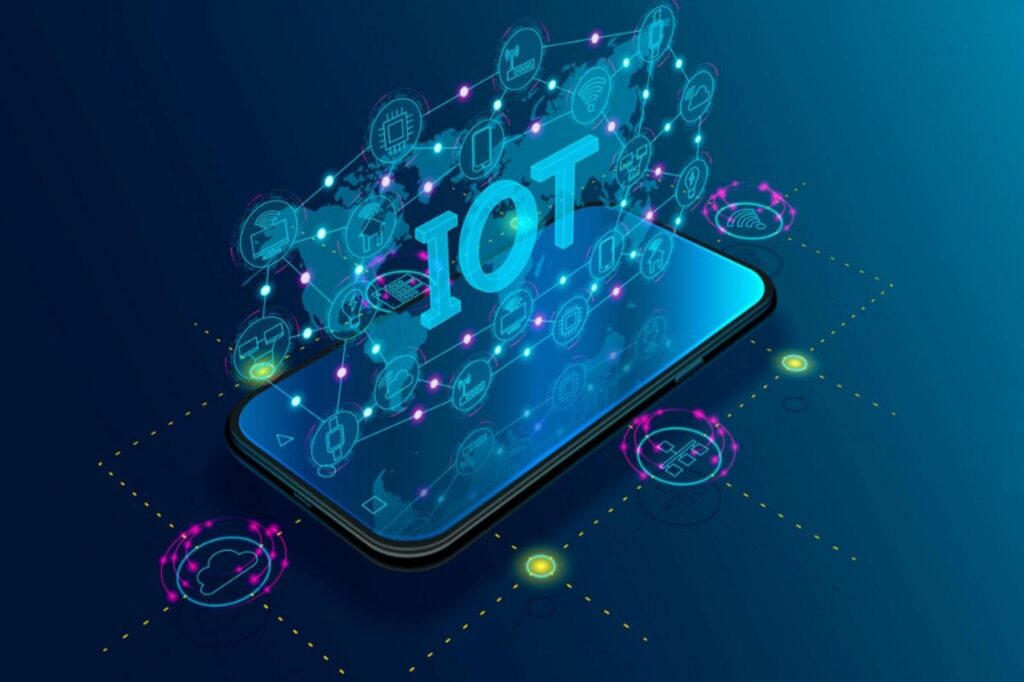Internet of Things devices can adjust their thermostats based on the schedule you set or brew coffee when your alarm sounds.
We now live in a connected world, where artificial intelligence is making everyday objects smarter. These cutting-edge technologies are being adopted by communities at a rate that is unprecedented. IoT devices, from smart thermostats and connected cars to IoT-enabled homes are changing the way people live and work. But being able regulate these gadgets is crucial for individuals as well as businesses.
With great power, comes great responsibility. Understanding how to manage these devices and their associated applications is crucial for optimizing the potential of each device while ensuring maximum efficiency.
Let’s get ready to learn the best techniques for controlling IoT devices. You will also get the necessary information to master this new technological frontier.
Controlling IoT devices in 2024
What now? The key is to control these gadgets with ease and power. In 2024, it’s likely that the ways to manage and monitor Internet of Things will go beyond web or mobile app integration. Today, both end users and operators of IoT industrial equipment are looking for new ways to communicate with connected devices.
We need to think about remote control options, as well as direct engagement. In addition to buttons, touch screens, sound and motion sensors and conventional touchscreens, they can automate and manage equipment.
We can therefore break the question How to Control IoT devices into two major answers: ” Physical” and ” Remote”.
Physical Control Methods
The Web of things devices are controlled by buttons, sensors and other physical components. The buttons, switches and sensors can be found either on the device itself or an external device which is wirelessly or wired attached.
Here are some of the most common physical controls.
Buttons for the body
The gadget can be operated directly by the user using the buttons that are built in. The buttons create a link directly between the user’s device and gadget, allowing for simple use. Smart thermostats, such as those in smart homes, can include physical buttons to adjust the temperature. This allows for quick and tactile adjustments.
External Buttons
External buttons can be used to increase the range of physical controls. The externalization of gadgets allows users to manipulate them without having direct contact with the device. It provides the ultimate in adaptability and ease. In industrial settings where the devices are in potentially hazardous conditions, external buttons provide a more safe and accessible control.
Body Switches
The integrated switches make the device more user-friendly. The switches are used to control the device’s power state, mode, or specific operations. Smart lighting systems, for instance, can have switches for switching ambient illumination to focused task illumination.
External switches
External switches are a physical alternative to buttons. Remotely changing settings and triggering actions is possible, allowing users to expand the scope of their device management. It is particularly useful when it is not practical to contact the device.
Touchscreens
The touch-screen devices in the IoT provide a dynamic and easy control that allows users to interact with sophistication. These devices are used to browse settings on consumer products such as refrigerators that have smart features.
Touch Sensors
Touch sensors, as opposed to screens and displays, detect specific touch gestures. The accuracy of control is improved by this subtle but effective technique. Touch sensors are also used in many wearable devices to allow users to interact with gadgets by tapping and swiping.
Controls for Gesture & Movement
In the same way, innovations in gestures and movements controllers allow people to interact naturally with gadgets. The hands-free technology provides an extra layer of convenience. It can be used by simply waving your hand around or doing certain movements. The controllers can also be used on gaming consoles or smart TVs for a more immersive experience.
Sound Sensors
The audio control layer is provided by sound sensors. Especially those that react to hand clapping. Simple sound cues can be used to initiate tasks, providing an accessible and additional mode of interaction. Smart home gadgets often include this feature to allow users to operate lights and appliances by clapping their hands.
Radio Remote Controls
The physical range of control is increased by radiofrequency remote controls. It is useful when the device is not operable or is dangerous. Radio remote controls are also used in industrial automation to allow personnel to operate machines safely from a distance.
Bluetooth remote controls
Bluetooth-enabled remote controllers make them more accessible. Remote management of devices gives people greater flexibility in their interaction with IoT. This is also useful when the physical proximity to the device or drone is restricted, as it is when using a Bluetooth enabled remote control.
Tag readers for RFID and NFC tags
If you want to learn How To Control IoT devices, RFID and NFC scanners will provide a smooth experience by identifying the tags. The solution provides an additional level of security and personalization, allowing tailored responses to devices based on the detected tags. Access control systems use RFID readers to validate IDs. This integration will increase the security of IoT enabled doors and gates.
Fingerprint Readers
The fingerprint reader, which is common for security applications, can be used to control smart devices. The fingerprint recognition can be used to verify the user, adding an additional layer of verification. It is important to do this when accessing sensitive data or devices is a priority.

Remote control methods
Only the device architecture, as specified by developers, can determine whether physical controls are available on an Internet of Things Device. The IoT platforms define remote control methods, so the completeness of the IoT user experience is dependent on the selection. Protecting sensitive data is essential.
Mobile App
Mobile Apps are the first step in How to control IoT devices. As universal controllers, smartphones enable direct connectivity between IoT device and themselves. Software created for smartphones enhances the firmware of Internet of Things (IoT) devices, and platform software on the cloud. Smartphones can connect to devices either directly through the cloud or indirectly via Wi-Fi. Cloud-based controls are more efficient than direct Wi-Fi and Bluetooth connections, which provide immediate access. The gadget is using the cloud to store data, as well as to receive commands from users and broadcast sensor information. Software that is run on the cloud also plays an important role, as it simplifies device logic and improves firmware reliability.
Mobile applications offer an intuitive interface that allows for easy interaction with IoT gadgets, regardless of how they are connected. The user can view real-time data on the IoT device, review historical sensor information and control its state including mode changing, power management and configuration settings including automation. Its user-friendly interface also makes the device more accessible for people of any age and skill level.
Security Perks
Mobile applications, especially those that integrate machine learning (like facial recognition), are crucial in protecting devices linked to the network, as they are susceptible due to constant access. The authentication systems of these apps verify the identity of the user before allowing access to the device. The use of mobile applications makes it easy to upgrade firmware on devices, which increases functionality and security.
Web application
Web applications, which are typically accessed through a web browser, do not need to be downloaded or installed. The web application runs smoothly in any browser regardless of operating system. In industrial IoT and medical IoT, web apps are used to help manage device fleets and provide assistance for system administrators or operators. They use system analysis technologies to gain real-time insight into the health of thousands devices.
In these environments, web apps thrive because the PC monitor or laptop screen can show more information than that of a smartphone. Although we tend to think of them as tools for professionals, they have a lot of potential when it comes to the consumer market. In some situations, a web-based application to control devices could be more convenient than a mobile app.
In addition, web-based apps are a great way to share control over devices. Online application links can be created by users, eliminating the need for recipients to download mobile applications or create an account. Online applications are now a more accessible alternative to mobile app.
Voice assistants
Voice assistants can help manage your home’s smart system. With a simple command, you can change the temperature, dim the lights and make your coffee – without having to lift a finger. It’s almost like living in an advanced technological fairytale, where all the magic happens with just a voice command. It is particularly useful when the user must perform multiple tasks or has limited physical access to their devices.
Voice assistants like Amazon Alexa, Apple Siri and Google Assistant are successful because vocal communication is the human’s most natural way of communicating. They can also manage media and retrieve information.
End users prefer to integrate control with existing voice assistants. Why? It is a simple and efficient way to utilize advanced functional and technological solutions.
It is also important to consider the option of executing voice commands directly through the IoT device, or via a different platform. It is necessary to add a microphone and speaker in order to record voice commands. This method, while viable, is also more expensive and complex, making it unsuitable for most situations.
Automation Scenarios and Smart Home Systems
Automation scenarios can be configured by system administrators or users. They provide an efficient way to operate IoT gadgets. The platforms and systems for smart homes can trigger device responses based on specific triggers. This allows them to function consistently across a range of environments. You can, for example:
The streetlights are activated by the readings of light sensors or by sunsets in specific regions.
Similar to the motion sensor, house lights can be activated when a noise or movement is detected.
A favorable weather forecast will also trigger automatic lawn watering when sensors in the soil detect dryness.
Automation is low-maintenance and requires just initial configuration. The system is self-contained and can be ignored by users once it has been set up. The system can be customized to alert users in non-standard situations or dangerous circumstances. The technology will also alert users if any sensor data is dangerous or faulty, like gas leaks and unusual room temperatures. It ensures safety and ease in automatic IoT device functioning.
Integration of Third-Party services via API
Third-party services such as Telegram bots or IFTTT connections to the service catalog can improve IoT device administration and automation. These integrations use APIs to facilitate the interaction of different software. The IoT platform and service are integrated directly, which allows for faster communication.
IFTTT, for example, is an intermediary service that allows control and automation of software programs without any prior knowledge. These connections are flexible, which opens the door to new possibilities. The gadgets can be managed by users based on Google Calendar, for example pausing the music when online meetings are taking place. A gadget can be deactivated or activated based on geolocation. Webhooks also allow interaction with other services not listed in the IFTTT Directory, allowing for a variety of personalized control scenarios.
SMS
It is the same as controlling gadgets via phone call. The gadget can be controlled by an SMS sent to a specific number, if that platform allows it. This may seem outdated in the current environment, but it is still relevant in certain cases. These methods are useful and reliable in places with intermittent mobile internet access or no Wi-Fi.
Phone calls
Internet of Things is older than the phone-based remote controls, which were widely used to control gates or barriers requiring users contact a particular number. In the past, SIM-equipped controllers simplified access by using the number of the caller to determine whether or not they could enter. Online services are replacing physical controllers as a way to modernize this. Users still dial a number, but the control is improved by using third-party applications.
The new technology allows customers to control devices remotely, change modes and toggle the power with just a phone call.
Email
Email is the final anchor to the How To Control IoT devices dive. Email is an alternative but possible way to control IoT. Sending mail to an address that has been pre-set allows users to easily adjust the working mode of the smart system.
Final Notes
We need to seize the future of connectivity! It’s important to understand IoT controls because these gadgets will become more and more integrated into our everyday lives. Anyone can manage their smart business or home environment with a bit of knowledge and enthusiasm.
IoT devices will continue to evolve as technology does. The possibilities of IoT devices are virtually endless.


